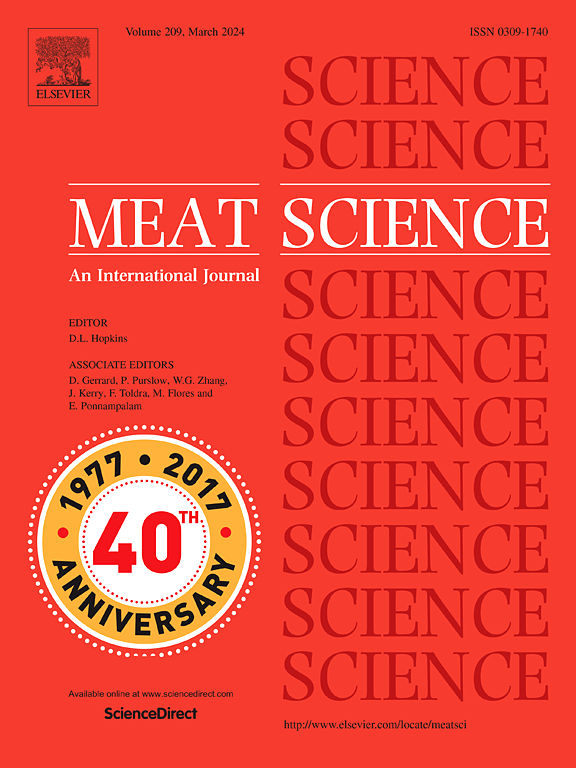脉冲光和贾布提卡巴皮提取物对摩台拉切片中亚硝酸盐的还原和品质的提高
IF 7.1
1区 农林科学
Q1 Agricultural and Biological Sciences
引用次数: 0
摘要
研究了脉冲光(PL)和贾布提卡巴皮提取物(JPE)在降低亚硝酸钠含量的情况下对切片摩台ella细菌生长的控制效果,并评估了它们对食品质量的影响。测试了三种配方:150 ppm亚硝酸盐(100%允许用量,N100%), 75 ppm亚硝酸盐(N50%)和75 ppm亚硝酸盐加1% JPE (N50% + JPE)。蒸熟后切片,用PL (5.28 J/cm2, 1046.9 W/cm2辐照度)处理,真空包装,4℃保存30天。贮藏30天后,N50%样品的TBARS值(0.54 vs. 0.18 mg MDA/kg)和中嗜氧好氧细菌总数(TMAB, 8.38 vs. 7.1 Log CFU/g)和乳酸菌(LAB, 8.21 vs. 6.17 Log CFU/g)均高于N100%。在N100%和N50%配方中,应用PL可使TMAB和LAB分别降低1.4-1.55 Log CFU/g和1.0-2.24 Log CFU/g (P <;0.05),但对pH和颜色有负面影响,增加了脂质氧化。JPE减轻了这些缺陷,并且JPE和PL组合具有增强的抗菌效果,N50% + JPE + PL样品的微生物数量与N100%的样品相似。JPE和PL的组合也显著降低了亚硝胺水平,这表明它是提高肉制品质量和安全的有效策略。本文章由计算机程序翻译,如有差异,请以英文原文为准。
Pulsed light and jabuticaba peel extract for nitrite reduction and quality enhancement in sliced mortadella
This study evaluated using pulsed light (PL) and jabuticaba peel extract (JPE) to control bacterial growth in sliced mortadella with reduced sodium nitrite content and assessed their impact on food quality. Three formulations were tested: 150 ppm nitrite (100 % of the allowed dosage, N100%), 75 ppm nitrite (N50%), and 75 ppm nitrite with 1 % JPE (N50% + JPE). The mortadella was cooked, sliced, treated with PL (5.28 J/cm2 fluence, 1046.9 W/cm2 irradiance), vacuum-packed, and stored at 4 °C for 30 days. N50% samples exhibited higher TBARS values (0.54 vs. 0.18 mg MDA/kg) and higher population counts of total mesophilic aerobic bacteria (TMAB, 8.38 vs. 7.1 Log CFU/g) and lactic acid bacteria (LAB) (8.21 vs. 6.17 Log CFU/g, respectively) than N100% after 30 days of storage. PL application reduced the TMAB and LAB by 1.4–1.55 Log CFU/g and 1.0–2.24 Log CFU/g for the N100% and N50% formulations (P < 0.05), respectively, but negatively affected pH and color, increasing lipid oxidation. JPE mitigated these defects, and combined JPE and PL presented an enhanced antimicrobial effect, with N50% + JPE + PL samples showing similar microbial counts to N100% over the storage. The combination of JPE and PL also significantly reduced nitrosamine levels, highlighting it as an effective strategy to improve the quality and safety of meat products.
求助全文
通过发布文献求助,成功后即可免费获取论文全文。
去求助
来源期刊

Meat Science
工程技术-食品科技
CiteScore
12.60
自引率
9.90%
发文量
282
审稿时长
60 days
期刊介绍:
The aim of Meat Science is to serve as a suitable platform for the dissemination of interdisciplinary and international knowledge on all factors influencing the properties of meat. While the journal primarily focuses on the flesh of mammals, contributions related to poultry will be considered if they enhance the overall understanding of the relationship between muscle nature and meat quality post mortem. Additionally, papers on large birds (e.g., emus, ostriches) as well as wild-captured mammals and crocodiles will be welcomed.
 求助内容:
求助内容: 应助结果提醒方式:
应助结果提醒方式:


